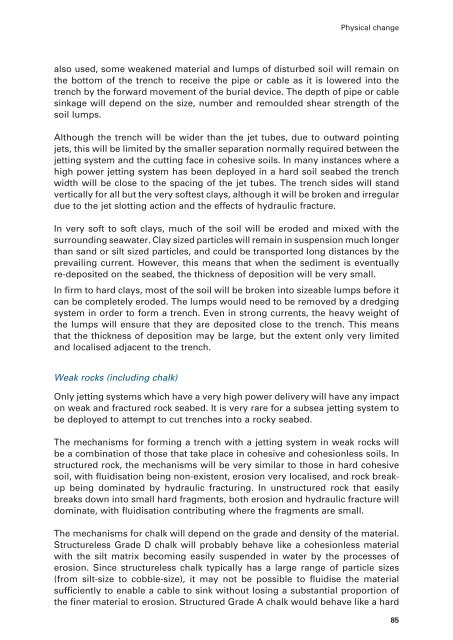Review of Cabling Techniques and Environmental Effects Applicable
Review of Cabling Techniques and Environmental Effects Applicable
Review of Cabling Techniques and Environmental Effects Applicable
Create successful ePaper yourself
Turn your PDF publications into a flip-book with our unique Google optimized e-Paper software.
Physical change<br />
also used, some weakened material <strong>and</strong> lumps <strong>of</strong> disturbed soil will remain on<br />
the bottom <strong>of</strong> the trench to receive the pipe or cable as it is lowered into the<br />
trench by the forward movement <strong>of</strong> the burial device. The depth <strong>of</strong> pipe or cable<br />
sinkage will depend on the size, number <strong>and</strong> remoulded shear strength <strong>of</strong> the<br />
soil lumps.<br />
Although the trench will be wider than the jet tubes, due to outward pointing<br />
jets, this will be limited by the smaller separation normally required between the<br />
jetting system <strong>and</strong> the cutting face in cohesive soils. In many instances where a<br />
high power jetting system has been deployed in a hard soil seabed the trench<br />
width will be close to the spacing <strong>of</strong> the jet tubes. The trench sides will st<strong>and</strong><br />
vertically for all but the very s<strong>of</strong>test clays, although it will be broken <strong>and</strong> irregular<br />
due to the jet slotting action <strong>and</strong> the effects <strong>of</strong> hydraulic fracture.<br />
In very s<strong>of</strong>t to s<strong>of</strong>t clays, much <strong>of</strong> the soil will be eroded <strong>and</strong> mixed with the<br />
surrounding seawater. Clay sized particles will remain in suspension much longer<br />
than s<strong>and</strong> or silt sized particles, <strong>and</strong> could be transported long distances by the<br />
prevailing current. However, this means that when the sediment is eventually<br />
re-deposited on the seabed, the thickness <strong>of</strong> deposition will be very small.<br />
In firm to hard clays, most <strong>of</strong> the soil will be broken into sizeable lumps before it<br />
can be completely eroded. The lumps would need to be removed by a dredging<br />
system in order to form a trench. Even in strong currents, the heavy weight <strong>of</strong><br />
the lumps will ensure that they are deposited close to the trench. This means<br />
that the thickness <strong>of</strong> deposition may be large, but the extent only very limited<br />
<strong>and</strong> localised adjacent to the trench.<br />
Weak rocks (including chalk)<br />
Only jetting systems which have a very high power delivery will have any impact<br />
on weak <strong>and</strong> fractured rock seabed. It is very rare for a subsea jetting system to<br />
be deployed to attempt to cut trenches into a rocky seabed.<br />
The mechanisms for forming a trench with a jetting system in weak rocks will<br />
be a combination <strong>of</strong> those that take place in cohesive <strong>and</strong> cohesionless soils. In<br />
structured rock, the mechanisms will be very similar to those in hard cohesive<br />
soil, with fluidisation being non-existent, erosion very localised, <strong>and</strong> rock breakup<br />
being dominated by hydraulic fracturing. In unstructured rock that easily<br />
breaks down into small hard fragments, both erosion <strong>and</strong> hydraulic fracture will<br />
dominate, with fluidisation contributing where the fragments are small.<br />
The mechanisms for chalk will depend on the grade <strong>and</strong> density <strong>of</strong> the material.<br />
Structureless Grade D chalk will probably behave like a cohesionless material<br />
with the silt matrix becoming easily suspended in water by the processes <strong>of</strong><br />
erosion. Since structureless chalk typically has a large range <strong>of</strong> particle sizes<br />
(from silt-size to cobble-size), it may not be possible to fluidise the material<br />
sufficiently to enable a cable to sink without losing a substantial proportion <strong>of</strong><br />
the finer material to erosion. Structured Grade A chalk would behave like a hard<br />
85
















